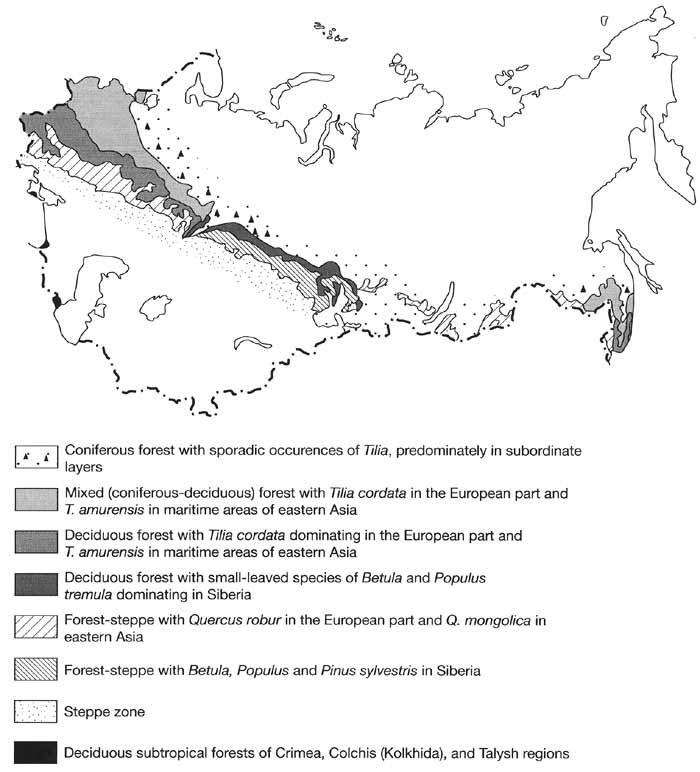Please put an active hyperlink to our site (www.rusnature.info) when you copy the materials from this page
Biomes and Regions of Northern Eurasia
Mixed and Deciduous Forests
<<< Boreal Forests: Conclusions | Biomes & Regions Index | Mixed and
Deciduous Forests of the East European Plain >>>
Introduction
Mixed (coniferous-deciduous) and deciduous forests occupy the middle part of the East
European plain and extend as a wedge-shaped belt from the Gulf of Finland and the
Carpathian foothills to the southern Urals (Figure 10.1). Mixed forests dominate on
watersheds in the northern and central parts of this belt. Deciduous forests extend
further south and gradually give way to forest-steppes.

Fig. 10.1 Natural zones of the middle belt of Northern Eurasia
The main stand species in mixed forests are spruce (Picea), pine (Pinus), oak
(Quercus), lime (Tilia), beech (Fagus), and birch (Betula). A relatively high proportion
of conifers is characteristic of the region. The biomes of mixed and deciduous forests
have a relatively mild climate and fertile soils. Four great ancient cities (Kiev,
Vladimir, Novgorod, and Moscow) are located here. Both crafts and agriculture began
developing in the earliest days of Russia's history and primary forests were therefore
heavily cleared and tilled. Mixed and deciduous forests also widely occur in the southern
Far East. In other regions of Northern Eurasia, the occurrence of deciduous and mixed
forests is mainly linked to altitudinal zonation. Deciduous forests usually develop in
intermountain depressions, while mixed forests occupy foothills and the lower and middle
sections of mountain slopes. This distribution is clearly expressed in the mountainous
regions of the Caucasus, Carpathians, and Crimea.
Controversial assessments have appeared concerning the origin of small-leaved forests
in the southern part of the West Siberian plain. The formation of Betula pendula, B.
krylovii, and Populus tremula stands, which dominate the area, has been traditionally
attributed to such human impacts as fires and felling. However, pollen analysis has shown
that these forests existed at least throughout the Holocene (Neistadt, 1976). According to
these data, the small-leaved forests of Western Siberia are original forests which form an
ecotone between taiga and forest-steppe. Pure deciduous forests are absent in Western
Siberia. Among deciduous species only Tilia cordata occurs locally in a subordinate forest
tier in the south-west of the Transurals region, extending to Tobolsk (58∞15'N; 68∞12'E)
in the north, and in some isolated habitats in the Kuznetsky Alatau. The extremely severe
winters and lack of moisture prevent mixed and deciduous forests from developing in
Eastern Siberia, where taiga borders directly with the forest-steppe biome.
Traditionally, mixed and deciduous forests have been treated as two separate zones
(Lavrenko and Sochava, 1956). However, because in many areas coniferous species penetrate
far south and deciduous forests do not form a continuous belt, it was suggested by some
physical geographers (Milkov and Gvozdetsky, 1976) that only one biome of mixed forests
should be recognized. It was also proposed that deciduous forests, together with meadow
steppes, should be viewed as a part of the forest-steppe zone (Milkov, 1986). It is
necessary to recognize, however, that the belt of deciduous forests is distinctly marked
in the middle part of the East European plain where deciduous species are dominants and
edificators. This fact supports the original and independent ordinance of the deciduous
forest zone and in this chapter I will approach mixed and deciduous forests of the
European territory as two different biomes. However, it should be acknowledged that
composition of tree species in the East European forests changes gradually in a
sub-meridional direction, from the north-north-west (where mixed forests dominate) to
south-south-east (where deciduous forests gradually give way to forest-steppes).
Vegetation distribution is complex, with transitional areas, and was best defined by
Agakhanyants (1986) as a mosaic. It is, therefore, difficult to draw precise boundaries
between the mixed and deciduous forest zones.
In this chapter, I will focus on the woodlands of plains and lower mountains. Although
primary forests still occupy vast areas, much of the woodlands have been degraded by human
impact throughout their history. Many areas, heavily forested in the past, have been
transformed. Here, I will concentrate on those areas where natural forests survived and
address the issue of the changing nature of forests in the concluding sections of the
chapter.
In the history of Northern Eurasia, forests have always played a very special role.
They provided food and shelter to its dwellers for centuries, from the times of the nomad
invasions to the Second World War. Hunting still is one of the main occupations for many
indigenous people and later settlers in the Far East. I will discuss the role of forests
in human history (concentrating on the European territory) and human impact on forests.
A comprehensive survey of mixed and deciduous forests was published by Kurnaev (1968)
and Agakhanyants (1986). Forests of the European territory are reviewed by Gribova et. al.
(1980). Walter (1974) provides a review in German and Jahn (1991) may be helpful to
English-speaking readers.
<<< Boreal Forests: Conclusions | Biomes & Regions Index | Mixed and
Deciduous Forests of the East European Plain >>>
Contents of the Mixed and Deciduous Forests
section:
Other sections of Biomes & Regions:
|
|